From Shoulder Rest to Collar Bone Rest
4. Strategies for shoulder rest adjustment
A unique solution for each player
To accommodate different body types, we adjusted the shoulder rest or substitutes for position, height, and shape and size of cushion. Each student devised a unique solution using the store-bought shoulder rests and cushions, often altering them and/or using them differently than before the research. Some students built their own shoulder rest substitutes using materials we had on hand and some chose to play without a shoulder rest. Toward the end of the research period, some players opted for the custom made shoulder rests designed by our technician. (To read more about their individual solutions, see “Musicians-stories.”)
The various choices of the players at the end of the research were:
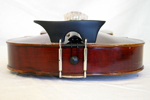
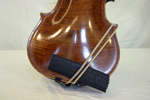
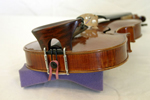
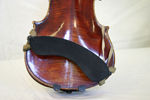
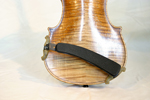
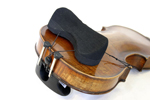
1. No shoulder rest
2. A shoulder rest substitute constructed by the musician
3. A commercially made sponge or cushion
4. A commercial model (often used differently than before the research)
5. An altered commercial model
6. A custom made shoulder rest constructed by our technician
Here you can read about problems we encountered and some of the solutions we came up with.
Problem: Pressure on left shoulder joint restricting movement
Strategy no.1: Turning and/or altering commercial shoulder rest
To bring the pressure off the tip of the shoulder, and onto the middle of the collar bone, some musicians turned their shoulder rests on the diagonal (see below). This brought the upper part of the shoulder rest onto the middle of the collar bone, freeing the shoulder joint for movement.
Whereas this seemed to work with the taller players, for smaller and middle-sized players, the lower part of the shoulder rest came to rest on the chest muscles, restricting movement there. This was a sign that the size of the bridge or pad was too large.
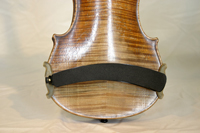
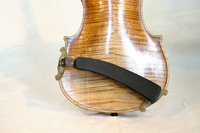
1. Usual shoulder rest position: can block the shoulder joint.
2. Diagonal position of shoulder rest: brings shoulder rest off the shoulder joint. This one has also been altered for size. *
Further alterations to the shape of the cushion section were sometimes made by attaching wool, chamois leather and/or ant-slip rubber to change the shape of the cushion.
*To decrease the size of the cushion area ( on the right) we used a Kun shoulder rest for ½ sized violin and altered it to fit the full sized violin by replacing the foot attachment with those from a full-sized shoulder rest model.
Strategy no. 2: Shoulder rest substitutes
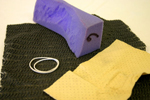
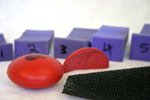
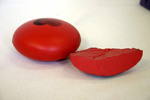
Some of the materials used by the musicians to construct their own shoulder rest substitutes.
Building your own shoulder rest substitute is sometimes the best solution when you can’t find a shoulder rest to fit you. Small wedges of hard sponge, pieces of chamois leather, etc. have long been used in the profession, sometimes under the clothing where they cannot be seen. The hand made shoulder rest can be attached to the instrument or slid under the clothing. Placing an extra sheet of ant-slip rubber on the clothing or skin of the player just under the instrument further helps prevents the instrument from slipping.
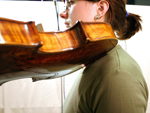
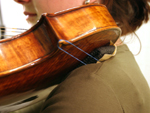
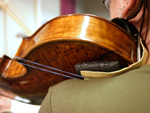
1. Viola rests on collar bone
2. Monica’s self-made “shoulder rest substitute”
3. The shoulder joint is free to move.
Example: Here Monica has invented her own shoulder rest which does not touch the tip of her shoulder joint. She needed only minimal support from the shoulder rest after her chin rest was corrected. A rolled-up sheet of anti-slip rubber is combined with a flap of chamois leather to protect the skin.
Problem: Shape of shoulder rest doesn’t fit player
When the shape of the shoulder rest does not match the contour of the violinist’s chest and collar bone, the violinist or violist has to search for the one place that the shoulder rest does fit, where she can get a grip. This can cause the instrument to be forced into a position that doesn’t suit the bow arm or fingering hand. To get support from the shoulder rest, the player tends to position the fingerboard too far to the left, making it hard to use the arms within their normal range of movement.
Some strategies:
Adjusting the shape of the entire cushion area (where it touches the player) is not usually an option with store-bought shoulder rests. Some rests have flexible bodies that can be bent. Others can only be altered in shape by the addition of fillers like foam rubber or pieces of wool cloth. We often then covered these fillers with a layer of anti-slip rubber. When this was not possible, and the problem could not be corrected by re-positioning the shoulder rest, then a shoulder rest substitute had to be constructed out of materials on hand. A custom made shoulder rest was often the best alternative.
Problem: Incorrect height adjustment
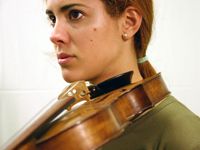
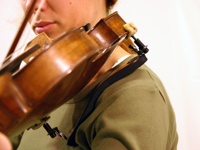
1. Violin positioned on collar bone
2.
A too-high shoulder rest raises violin off collar bone
When the shoulder rest is raised instead of the chin rest to accommodate a long neck, then the upper end of the shoulder rest is too high, taking the violin off the collar bone, removing the essential support that the collar bone provides. Skeletal resonance is decreased, limiting sound.
“The violin has to be on the collarbone because that is the focus point of the balance between you and the violin.” - Iren
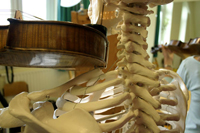
Violin on the collar bone: the skeletal structure contributes to the total sound produced by resonating with the instrument.
When the support of the collar bone directly below the instrument is removed, the player must clamp the instrument in place between jaw and shoulder, partly immobilizing the jaw, neck and the left shoulder.
Strategy: Low at collar bone, high at breast bone
The instrument should rest on the collar bone, near the throat. After the chin rest is adjusted to accommodate the length of the neck and the shape of the jaw, etc., then the shoulder rest height should be adjusted so as not to take the instrument up off the collar bone. Then the shoulder rest will not interfere with the support of the chin rest.
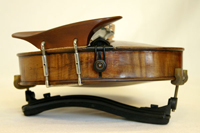
Shoulder rest adjusted to be low at collar bone end (left) and high at breastbone end (right).
Low at collar bone
The section of the shoulder rest that rests on the collar bone often needs to be lowered after the chin rest has been adjusted. By turning the screw foot all the way down, the instrument can come to rest on the collar bone. (Some taller players need this foot a bit higher than the lowest setting.)
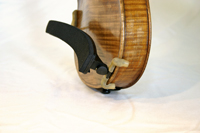
KUN screw foot at the lowest setting
The Wolf shoulder rests have a feature that allows you to lower the foot further by turning the entire screw attachment around and re-inserting the screw. (This is fully animated on their website: make link)
Another solution that Willy Wolf himself devised for one of our students proved useful. We used a model that had no screw feet, which allowed it to be even lower at the collar bone end.* To obtain the necessary height at the breast bone end, we then replaced the plain foot with a screw foot (and attachment) taken from another model.**
*Models with no screw foot at collar bone end:
violin: Wolf forte-secondo standard
viola: Wolf standard-primo
**Screw foot attachment replacement for breast bone end taken from models:
violin: Wolf forte-secondo
viola: Wolf forte-primo
High at breast bone
When the lower end of the shoulder rest is not high enough, the neck of the instrument can drop downwards, or the instrument can slide along the chest. This makes it difficult for the player to hold the instrument up, and causes them to bring the shoulder around to the front and up to try to fill the space.
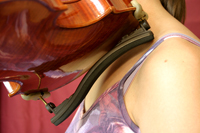
The gap between the shoulder rest and the violinist shows how far the left shoulder has to come forward to meet the shoulder rest.
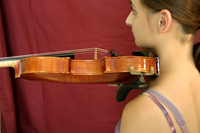
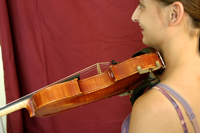
1. Researcher holds the violin up for Willemijn.
2. Violin is then allowed to drop onto the chest, showing that the shoulder rest is too low.
Here we showed Willemijn how her old shoulder rest was too low at the breast bone end. Before the research she had not noticed this because she had developed the habit of raising her shoulder and pulling it forward to fill the gap.
There is more space to be filled at the breast bone end of the shoulder rest than at the collar bone end. You can heighten this end of the shoulder rest by adjusting the screw foot to the highest setting
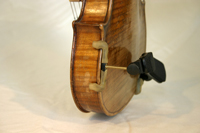
Highest KUN screw foot
In the Wolf model, there is a double screw system (one screw inside another) with the result that you can raise it quite high, but players often do not notice this feature. The KUN company makes different height screw feet available for separate purchase; we found the highest most useful. We often added extra padding to this end of the shoulder rest, either wool or foam rubber, and covered it with anti-slip material to prevent slippage.
For some tall players, it was not possible to raise the breast bone end of the shoulder rest high enough, and they learned to play solely with the support of the collar bone end, with the shoulder rest not touching the chest at all. This seemed to work for them, as long as the chin rest was properly adjusted to give sufficient support.
